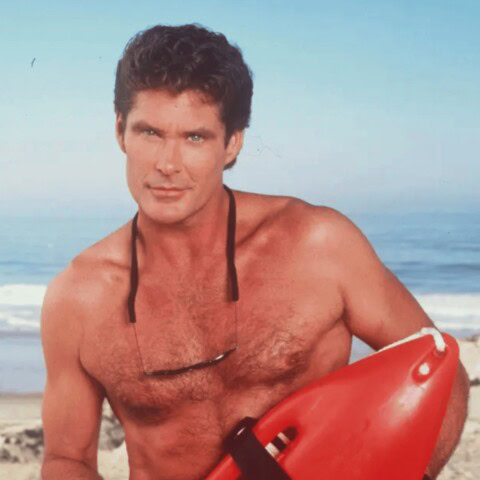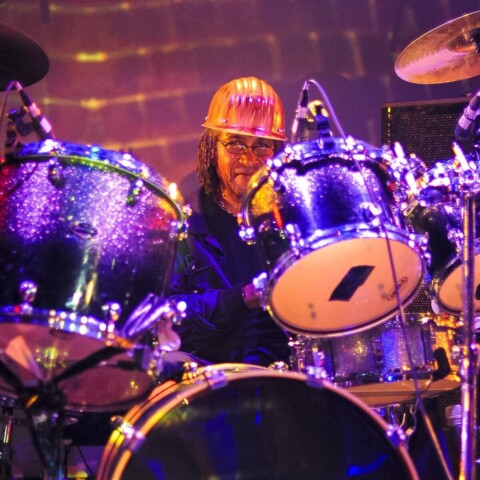GARY STEEL with a personal appreciation of Mike Nesmith that extends far beyond his brief time in The Monkees.
 Mike Nesmith wasn’t notable just because he was the Monkee with the woolly hat but because he wore so many hats during his lifetime, each of them the product of innovative, sharp and intelligent thinking – all in his dependably idiosyncratic way.
Mike Nesmith wasn’t notable just because he was the Monkee with the woolly hat but because he wore so many hats during his lifetime, each of them the product of innovative, sharp and intelligent thinking – all in his dependably idiosyncratic way.
Watching or reading mainstream media’s eulogies to Nesmith after his death, however, he was pretty much reduced to The Monkees, “the quiet one” and that hat.
Would you like to support our mission to bring intelligence, insight and great writing to entertainment journalism? Help to pay for the coffee that keeps our brains working and fingers typing just for you. Witchdoctor, entertainment for grownups. Your one-off (or monthly) $5 or $10 donation will support Witchdoctor.co.nz. and help us keep producing quality content. It’s really easy to donate, just click the ‘Become a supporter’ button below.
Normally, superficial media coverage of a deceased rock star wouldn’t offend me. But there was nothing “normal” about Nesmith, his trajectory through the entertainment industry, or indeed his life story. It would have been gratifying had the coverage acknowledged the brief success he’d had as a member of the first television-created pop group, but also covered some of the achievements of his long career, many of which were newsworthy.
Had Nesmith lived to see these too-brief eulogies, I’m sure he’d have been insulted to learn that, as far as mainstream media was concerned, the millstone that hampered his progress for so many years – The Monkees – was being turned into the only notable event of his fascinating life. In later years he came to terms with those few years in the ‘60s when the group achieved even greater success than the band they were modelled on – The Beatles – and even performed some (admittedly fairly dodgy) reunion shows with surviving former members.
 Nesmith’s life story would have made a fascinating biopic, given its unlikely detours, but because he didn’t fit the mould his work has often gone unacknowledged in the places that matter. A glaring example of this is his complete absence from Ken Burns’ epic Country Music documentary, which devoted plenty of time to country-rock crossover artists but failed to even mention the glorious run of country albums Nesmith made in the wake of The Monkees.
Nesmith’s life story would have made a fascinating biopic, given its unlikely detours, but because he didn’t fit the mould his work has often gone unacknowledged in the places that matter. A glaring example of this is his complete absence from Ken Burns’ epic Country Music documentary, which devoted plenty of time to country-rock crossover artists but failed to even mention the glorious run of country albums Nesmith made in the wake of The Monkees.
Like many fans, I first came across Nesmith in The Monkees, a television show about a band of pop musicians. Back then (‘66/’67), transmission of TV in New Zealand was black and white, so it wasn’t until reruns in the early ‘80s that I finally saw the show in the lurid colour tones typical of the era. As a pre-teen, I didn’t give a rat’s ass whether the group was real or whether they wrote their own songs. The psychedelia was only just getting going and it was still common for bands and solo artists to cover other artists’ songs. For its brief run, The Monkees made for smart, fun viewing, its characters were likeable and each episode had a couple of great songs. Even though it was inevitably influenced by The Beatles’ Richard Lester-directed Hard Days’ Night and Help! the fact that it was beaming out to us every week into our living rooms made it a much more intimate experience.
 It wasn’t surprising that the producers thought it apt to pretend that The Monkees were a real group and launch them as a pop phenomenon with singles and long-playing records. The results were, surprisingly, fantastic. Songs by some of the finest songwriters of the era were utilised and some of the finest session players were used to generate the music. And that’s where the weird gets going, because the “members” of this fake band could actually play and in Michael Nesmith, they had a burgeoning songwriter who had been on the cusp of making it prior to accepting The Monkees role. I won’t go into the machinations but ultimately, the group wrestled control and did get to perform on their own records and even toured with Jimi Hendrix, who became good mates with “the Nes”.
It wasn’t surprising that the producers thought it apt to pretend that The Monkees were a real group and launch them as a pop phenomenon with singles and long-playing records. The results were, surprisingly, fantastic. Songs by some of the finest songwriters of the era were utilised and some of the finest session players were used to generate the music. And that’s where the weird gets going, because the “members” of this fake band could actually play and in Michael Nesmith, they had a burgeoning songwriter who had been on the cusp of making it prior to accepting The Monkees role. I won’t go into the machinations but ultimately, the group wrestled control and did get to perform on their own records and even toured with Jimi Hendrix, who became good mates with “the Nes”.
By ’68 the wheels were coming off but somehow, the everything-goes, hallucinogenic mindset of the times enabled the financing and completion of the Bob Rafelson-directed and Jack Nicholson-starring Head, a completely insane motion picture that had all the group’s teeny fans wondering what the fuck was going on. I saw it at the Embassy Theatre in Hamilton as a 9-year-old, and the fact that I didn’t understand much didn’t prevent me from thoroughly enjoying the trippy experience.
But I’ve already tapped out too much about The Monkees. As much as I’ve a big nostalgic soft spot for them, Nesmith’s subsequent achievements (to me, at least) easily eclipse them.
 There’s the (frankly nuts) 1967 solo debut album, The Wichita Train Whistle Sings, for starters. Bizarrely, this is an instrumental album recorded with a big band that included members of the famous “Wrecking Crew”, and it’s a completely oddball release that sounds nothing like anything else he ever released.
There’s the (frankly nuts) 1967 solo debut album, The Wichita Train Whistle Sings, for starters. Bizarrely, this is an instrumental album recorded with a big band that included members of the famous “Wrecking Crew”, and it’s a completely oddball release that sounds nothing like anything else he ever released.
Nesmith’s songs for The Monkees give more of a taste of where he was to go with his “proper” solo albums, however. ‘Tapioca Tundra’ is a great slice of bizarre psychedelia, while both ‘Mary Mary’ and ‘Listen To The Band’ hint at the country-rock direction he would take on the delicious series of underrated albums he would release for RCA, starting with Magnetic South in 1970. I’d moved on from The Monkees by then and the first few times I heard ‘Joanne’ (one of his few big hits) on the radio, I had no idea it was ol’ woolly hat. (A few years before I’d loved the song ‘Different Drum’ by Linda Rondstadt & The Stone Ponys without knowing that was penned by Nesmith, too!)
 But let’s pause on ‘Joanne’ for a minute, because it has such a unique place in popular music and I’m not sure that it ever got its dues. Rising to 21 on the American charts, in New Zealand, it zoomed right up to the top! Musically, it’s a gorgeous mix of storytelling and crooning and it somehow has the nostalgic hues of the 1940s about it. Lyrically, however, it’s very contemporary to the 1970s. As with so many of his songs, the dissections of relationships can sound a little sexist in these post #me-too times, but their almost painful analysis of failure still rings true.
But let’s pause on ‘Joanne’ for a minute, because it has such a unique place in popular music and I’m not sure that it ever got its dues. Rising to 21 on the American charts, in New Zealand, it zoomed right up to the top! Musically, it’s a gorgeous mix of storytelling and crooning and it somehow has the nostalgic hues of the 1940s about it. Lyrically, however, it’s very contemporary to the 1970s. As with so many of his songs, the dissections of relationships can sound a little sexist in these post #me-too times, but their almost painful analysis of failure still rings true.
There were six great albums between 1970 and 1973, all of which ended up on critics best-of lists and in cut-out (deletion) bins. That’s how I managed to afford them all as a school kid with a paper round: 99 cent deletions mail-ordered from Dirty Jacks somewhere in America, four months on a ship across the equator and usually some flattening of warps to deal with once they’d been wrestled from an overzealous customs official in Hamilton.
 Nesmith was never a great vocalist and sometimes he tries for a note that’s just a bit of a squeeze. But the same was true of that other great country music renegade, Kris Kristofferson, and I love his records of the era, too. There are in fact, several similarities between the two: both came from wealthy families and both were highly educated and literate. Words mattered to them. Their country music wasn’t quite pure or authentic but they were both incredible songwriters. In Nesmith’s case, he had the wherewithal to record those albums with the best Nashville session musos including the incredible pedal steel guitarist, Red Rhodes. And there’s the wit embedded in the name of his 1972 album, And The Hits Just Keep On Comin’. (Proof, perhaps, that Americans do know irony?) For many, his final RCA album, Pretty Much Your Standard Ranch Stash, is his best, and it’s hard to argue with critical consensus when it contains a song as great as ‘Some Of Shelly’s Blues’.
Nesmith was never a great vocalist and sometimes he tries for a note that’s just a bit of a squeeze. But the same was true of that other great country music renegade, Kris Kristofferson, and I love his records of the era, too. There are in fact, several similarities between the two: both came from wealthy families and both were highly educated and literate. Words mattered to them. Their country music wasn’t quite pure or authentic but they were both incredible songwriters. In Nesmith’s case, he had the wherewithal to record those albums with the best Nashville session musos including the incredible pedal steel guitarist, Red Rhodes. And there’s the wit embedded in the name of his 1972 album, And The Hits Just Keep On Comin’. (Proof, perhaps, that Americans do know irony?) For many, his final RCA album, Pretty Much Your Standard Ranch Stash, is his best, and it’s hard to argue with critical consensus when it contains a song as great as ‘Some Of Shelly’s Blues’.
 The album that’s rarely discussed is The Prison (1974), released the year after his RCA contract lapsed and released on his own Pacific Arts label. By this time, Nesmith was disenchanted with the business and contemplating his navel. The result was an album in a box with a book designed to be read while you were listening to the music. It’s a major departure from previous albums in every respect, but in its way, just as great. The music still employs hints of his previous country orientation but it’s built on gentle repetitive cycles featuring acoustic guitar and gentle, lulling synths. It has been noted as the first New Age album, and certainly lyrics like “being at one with the joys of rebirth” more than hint at the largely Los Angeles-based phenomenon. But it’s not just flaccid feel-good stuff. Deeply introspective and full of hurt and doubt, despite its attempt to reassure and make you feel better in a damaging world, The Prison is a kind of masterwork.
The album that’s rarely discussed is The Prison (1974), released the year after his RCA contract lapsed and released on his own Pacific Arts label. By this time, Nesmith was disenchanted with the business and contemplating his navel. The result was an album in a box with a book designed to be read while you were listening to the music. It’s a major departure from previous albums in every respect, but in its way, just as great. The music still employs hints of his previous country orientation but it’s built on gentle repetitive cycles featuring acoustic guitar and gentle, lulling synths. It has been noted as the first New Age album, and certainly lyrics like “being at one with the joys of rebirth” more than hint at the largely Los Angeles-based phenomenon. But it’s not just flaccid feel-good stuff. Deeply introspective and full of hurt and doubt, despite its attempt to reassure and make you feel better in a damaging world, The Prison is a kind of masterwork.
It’s the album he performed alone on the stage of the Hamilton Founders’ Theatre on a Stetson/Stewart McPherson tour the following year, and to similarly tiny audiences around the length and breadth of New Zealand. I think I counted 16 bodies there that night. We were dotted around the theatre, so Nesmith asked us all to come up to the two front rows, where we were treated to one of the most incredibly intimate sets I’ve ever witnessed.
https://www.youtube.com/watch?v=WnpcTsy10dE
And then… he seemed to disappear. Until he was reborn in 1977 with a completely different sound on the typically oddly-titled From A Radio Engine To A Photon Wing. I would swear that, in New Zealand at least, its single ‘Rio’ was a big hit. It was certainly one of his most earwormy and swoonsome songs. The country sound had disappeared, although the nostalgic glow to his music remained. (Note: Dedicated chart-watcher Simon Grigg tells me that it got to Number 4 on the NZ chart and stayed in the Top 40 for a rather astonishing four months!)
https://www.youtube.com/watch?v=Mi0b8tcCQSE
By the time of its follow-up, Infinite Rider On The Big Dogma (WTF?!?) Nesmith was fully into the development of a scheme to do something really radical: provide video clips for songs. Don’t forget, this was pre-MTV, and promo clips tended still to be simple miming to songs. The song that kicked off the new video-clip revolution was ‘Cruisin’’, otherwise known as ‘Lucy And Ramona And Sunset Sam’, and the video – primitive by today’s standards – is still surprising in context.
https://www.youtube.com/watch?v=t6GUpmHFvME&list=PLU_ycxo-Q7PspWqZCya2VD0mQbXMuO-sA
Nesmith laid the groundwork for the enterprise that became MTV, but ended up relinquishing his involvement before it debuted on American screens. Instead, he developed the music and comedy show Elephant Parts, another innovative creation that won a Grammy. Nesmith’s excellent memoir, Infinite Tuesday, goes into detail about his various innovative business schemes and entrepreneurial projects in the ‘80s and ‘90s, but all that’s beyond the remit of this little ode to ‘the Nes’.
 (And I didn’t even mention that his Mum was an innovator, too: she invented typing correction fluid Liquid Paper, and made a fortune. She died when she was only 56.)
(And I didn’t even mention that his Mum was an innovator, too: she invented typing correction fluid Liquid Paper, and made a fortune. She died when she was only 56.)
As a music journalist, I’ve intentionally remained somewhat aloof from all of this tribute malarkey. I’ve always liked the idea of writing about the music, not the person. Generally, I don’t know these guys even though I love their work. But with Nesmith’s death, I can’t help getting a little tearful. Yeah, he was 78 so not a young man. But what a dude. The guy had genuine intelligence to go with his innate talent, and when you like the way someone thinks and puts words together, it’s hard to imagine they’re not going to be around anymore. And, you know… he was one of the good guys.
Mike Nesmith – 30 December 1942 – 10 December 2021.
(Note: If I’ve made any factual errors, please step up and tell me. It was all written up in a state of gloom.)















